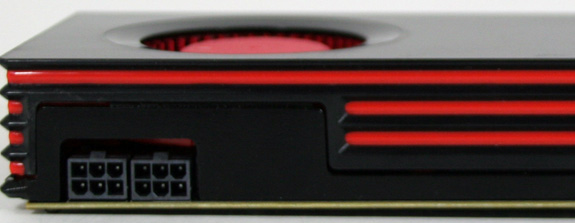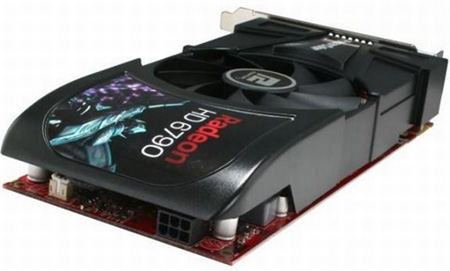AMD's Radeon HD 6790: Coming Up Short At $150
by Ryan Smith on April 5, 2011 12:01 AM ESTThe last couple of weeks after the recent GeForce GTX 550 Ti launch have been more eventful than I had initially been expecting. As you may recall the GTX 550 Ti launched at $150, a price tag too high for its sub-6850 performance. I’m not sure in what order things happened – whether it was a price change or a competitive card that came first – but GTX 550 Ti prices have finally come down for some of the cards. The average price of the cheaper cards is now around $130, a more fitting price given the card’s performance.
The timing for this leads into today’s launch. AMD is launching a new card, the Radeon HD 6790, at that same $150 price point. Based on the same Barts GPU that powers the Radeon HD 6800 series, this is AMD’s customary 3rd tier product that we’ve come to expect after the 4830 and 5830. As we’ll see NVIDIA had good reason to drop the price on the GTX 550 if they didn’t already, but at the same time AMD must still deal with the rest of the competition: NVIDIA’s GTX 460 lineup, and of course AMD itself. So just how well does the 6790 stack up in the crowded $150 price segment? Let’s find out.
| AMD Radeon HD 6870 | AMD Radeon HD 6850 | AMD Radeon HD 5830 | AMD Radeon HD 6790 | AMD Radeon HD 5770 | |
| Stream Processors | 1120 | 960 | 1120 | 800 | 800 |
| Texture Units | 56 | 48 | 56 | 40 | 40 |
| ROPs | 32 | 32 | 16 | 16 | 16 |
| Core Clock | 900MHz | 775MHz | 800MHz | 840MHz | 850MHz |
| Memory Clock | 1.05GHz (4.2GHz data rate) GDDR5 | 1GHz (4GHz data rate) GDDR5 | 1GHz (4GHz data rate) GDDR5 | 1050MHz (4.2GHz data rate) GDDR5 | 1.2GHz (4.8GHz data rate) GDDR5 |
| Memory Bus Width | 256-bit | 256-bit | 256-bit | 256-bit | 128-bit |
| VRAM | 1GB | 1GB | 1GB | 1GB | 1GB |
| FP64 | N/A | N/A | 1/5 | N/A | N/A |
| Transistor Count | 1.7B | 1.7B | 2.15B | 1.7B | 956M |
| Manufacturing Process | TSMC 40nm | TSMC 40nm | TSMC 40nm | TSMC 40nm | TSMC 40nm |
| Price Point | ~$200 | ~$160 | N/A | $149 | ~$110 |
3rd tier products didn’t get a great reputation last year. AMD and NVIDIA both launched such products based on their high-end GPUs – Cypress and GF100 respectively – and the resulting Radeon HD 5830 and GeForce GTX 465 were eventually eclipsed by the GeForce GTX 460 that was cooler, quieter, and better performing at the same if not lower price. The problem with 3rd tier products is that they’re difficult to balance; 1st tier products are fully enabled parts that are the performance kings, and 2nd tier products are the budget minded parts that trade some performance for lower power consumption and all that follows.
While 2nd tier products are largely composed of salvaged GPUs that couldn’t make it as a 1st tier product, the lower power requirements and prices make the resulting video card a solid product. But where do 3rd tier products come from? It’s everything that couldn’t pass muster as a 2nd tier product – more damaged units functional units that won’t operate at lower voltages like a 2nd tier product. The GTX 465 and Radeon HD 5830 embodied this with power consumption of a 1st tier card and the performance of a last generation card, which made them difficult to recommend. This does not mean that a 3rd tier card can’t be good – the Radeon HD 4830 and GTX 260 C216 were fairly well received – but it’s a difficult hurdle to overcome.
Launching today is the Radeon HD 6790, the 3rd tier Barts part and like the rest of the Barts-based lineup, the direct descendent of its 5800 series counterpart, in this case the Radeon HD 5830. As is to be expected, the 6790 is further cut-down from the 6850, losing 2 SIMD units and half of its ROPs; mitigating this some are higher clockspeeds for both the core and the memory. With 800 SPs and 16 ROPs operating at 840MHz, on paper the 6790 looks a lot like a Radeon HD 5770 with a 256bit bus, albeit one that’s clocked slower given the 6790’s 1050MHz (4.2GHz data rate) memory clock.
From the 5830 we learned that losing the ROPs hurts far more than the SPs, and we’re expecting much of the same here; total pixel pushing power is halved, and MSAA performance also takes a dive in this situation. Overall the 6790 has 90% of the shading/texturing, 54% of the ROP capacity, half the L2 cache, and 105% of the memory bandwidth of the 6850. Or to compare it to the 5770, it has 98% of the shading/texturing capacity, 98% of the ROP capacity, and 175% of the memory bandwidth, not accounting for the architectural differences between Barts and Juniper.
Further extending the 5830 comparison, as with the 5830 AMD is leaving the design of the card in the hands of their partners. The card being sampled to the press is based on the 6870’s cooler and PCB, as the 6790’s 150W TDP is almost identical to the 151W TDP of the 6870, however like the 5830 no one will be shipping a card using this design. Instead all of AMD’s partners will be using their own in-house designs, so we’ll be seeing a variety of coolers and PCBs in use. Accordingly while we can still take a look at the performance of the card, our power, temperature, and noise data will not match any retail card – power consumption should be very close however.

At 150W AMD is skirting the requirement for 2 PCIe power sockets. Being based on a 6870 our sample uses 2 sockets and any other design using a 6870 PCB verbatim should be similar, but some cards will ship with only a single socket. This doesn’t impact the power requirements of the card – it’s roughly 150W either way – but it makes the card more compatible with lower-wattage PSUs that only come with 1 PCIe power plug.

As we mentioned previously, AMD is launching the 6790 at $150. With the GTX 550’s price drop its direct competitor is no longer the GTX 550, but rather the closest competitor is now cheap GTX 460 768MB cards, which on average are about the same $150. AMD’s internal competition is the 6850, which averages closer to $160. Technically the Radeon HD 5770 is also competition, but with it going for around $110 after rebate, it’s far more value priced than the 6790 is.
Meanwhile the 6790 name also marks the first time we’ve seen the 6700 series in the retail market. In the OEM market AMD has rebadged the 5700 series as the 6700 series, however that change won’t ever be coming to the retail market, making this the only 6700 series card we’ll see. It’s a bit odd to see one series shared by two GPUs so significantly different, but AMD bases this on the fact that the 5770/6770 and the 6790 are so close in terms of specs; they want to frame the 6790 in terms of the 5770/6770, rather than in terms of the 6800 series. If nothing else it’s a nice correction for the poor naming of the 6800 series; a 6830 would have been the 5830 but slower.
| April 2011 Video Card MSRPs | ||
| NVIDIA | Price | AMD |
| $700 | Radeon HD 6990 | |
| $480 | ||
| $320 | Radeon HD 6970 | |
| $240 | Radeon HD 6950 1GB | |
| $200 | Radeon HD 6870 | |
| $160 | Radeon HD 6850 | |
| $150 | Radeon HD 6790 | |
| $130 | ||
|
|
$110 | Radeon HD 5770 |















69 Comments
View All Comments
silverblue - Tuesday, April 5, 2011 - link
Until we shift from 40nm, probably.mgl888 - Tuesday, April 5, 2011 - link
Not much they can do without a process shrink. Architectural improvements can only go so far.Taft12 - Tuesday, April 5, 2011 - link
No, there is no wall to speak of. The 4870 was a "first tier" part and this 6790 is "third tier". Compare the performance of the 4870 with a 6970 instead (and indeed the launch price of the 4870 with the launch price of the 6970) and you'll see we are doing just fine thank you very much.tno - Tuesday, April 5, 2011 - link
But not long after release the 4890 was retailing after discounts for $160-150. That's what I bought mine at and I have yet to find a compelling card to take its place. Part of that does have to do with a decrease in my gaming, but if I was a budget gamer, I would look long and hard at a used 4890.tno - Tuesday, April 5, 2011 - link
+1pandemonium - Wednesday, April 6, 2011 - link
Only if you don't consider the broad picture and are looking at performance individually.marc1000 - Tuesday, April 5, 2011 - link
I have a 5770. and even with the desire to upgrade to 6950/gtx570, i try to remain honest with me and tell to myself: "I don't need it"this level of performance if perfectly fine to play all current games, because we are all stuck with console ports...
jordanclock - Tuesday, April 5, 2011 - link
I have a 5770 as well, and at 1680x1050, almost everything runs flawlessly, even with AA at 2x or 4x. The situation with multiplatform development is starting to really agitate PC gamers, I think. Crysis 2 looks infinitely better on PC (And ultra high end setups run tri-monitor quite well!), Dragon Age 2 has a texture pack that consoles wouldn't even have the memory to use, and so many games are looking identical on PC and console, meaning that while they run at high framerates on modest hardware, there is no option to increase visual fidelity to offset the increased hardware.tno - Tuesday, April 5, 2011 - link
I concur. I have a 4890 that I picked up for $160 not long after its release after discounts. This thing was top tier, and it was pretty unique product coming out when ATI started treating their multi-GPU single card solutions as their true halo products. And for its flaws (noisy, power hungry and no DX11) it competes for performance at its original price.This is mirrored, frankly, in the PC market where the effective performance increase, that is performance that the average PC user (not us) will notice, has remained fairly flat since Conroe. What has improved is features. For that same budget dual-core Conroe price you get an integrated GPU worth its salt, improved efficiency, improved encoding/decoding performance (the thing users might notice most) and, possibly, more cores.
kmmatney - Tuesday, April 5, 2011 - link
I also have a HD4890, bought for $170, and attached an Accelero S1 cooler, so its virtually silent (only a very slow spinning fan that I can't hear across the heatsink). I'm still amazed after so much time that I cannot get a better card for the same price - things just haven't progressed much in the bang-for-buck department.